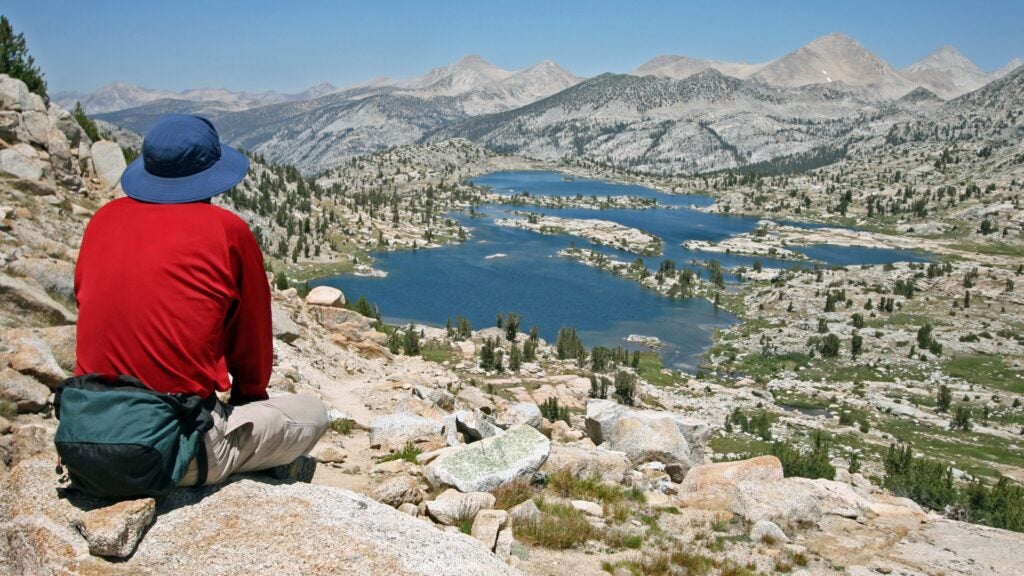No products in the cart.
Outdoor Adventure
A Beginner’s Guide to the John Muir Trail
I first experienced the Sierra Nevada while thru-hiking the Pacific Crest Trail when I was 20. As I approached from the south, the prominent mountains were an intimidating sight, rising thousands of feet from the desert. I was new to thru hiking, and didn’t know the first thing about snow travel, but I was immediately hooked because the scenery was so breathtaking.

That was also my first foray on the John Muir Trail, as much (but not all) of the 211-mile JMT overlaps the PCT. I was so inspired that over the next ten years I returned to the JMT three different times, completing two immersive thru-hikes and later setting the fastest known time on the classic trail. Each time I covered it differently: with a friend, then alone, and, finally, with very little sleep while going for the record.
What makes the JMT so special? The campsites are incredibly beautiful, as only pristine backcountry sites can be, the alpine lakes pristine, and the trail culture a major part of the endeavor. Yet even with the significant elevation and distance, it’s accessible for every level of hiker. With some planning, resupplying is straightforward, and enough other hikers are typically around that you never feel completely alone.
After I backpacked the JMT in 2011, as part of my Pacific Crest Trail thru-hike, the pictures and stories of adventure I relayed to my parents encouraged them to take three weeks off work and fish their way along the trail, something I helped them plan. From bear-can basics to can’t-miss campsites, there are a lot of logistics to consider. But you can tackle it—and should—because the John Muir Trail is ideal for everything from a short backpacking trip to the full go from start to finish.
Which Direction Should I Walk the Route?
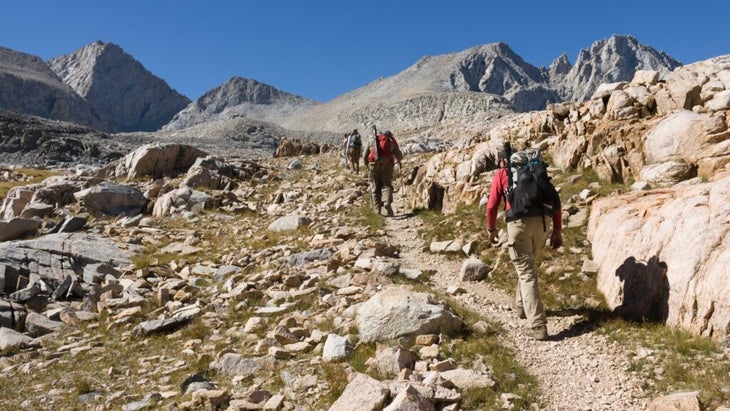
Most JMT thru-hikers start from the northern terminus in Yosemite National Park and head south to finish atop Mount Whitney. The reason: altitude acclimatization. Because Yosemite is the trail’s lowest point—4,000 feet elevation—and Whitney the highest—14,505 feet—backpackers usually take a couple days to get used to the thinner air before slowly making their way to the trail’s higher terrain. It’s a better experience.
The first half of the trail, when setting out from Yosemite Valley, stays fairly low in elevation, with only brief sections above 10,000 feet. The highest passes happen on the southern end. Organizing your trip from north to south means you can hike yourself into shape and have the stamina to more fully enjoy the difficult sections later; however, since most thru-hikers opt for southbound route, those permits can be tough to come by (I go into the permit process in detail below). Here are three different starting points at Yosemite to choose from.
The Most Popular Yosemite Trailheads
Happy Isles Trailhead: This is the official start of the John Muir Trail and, as such, the most competitive for permits. Located in Yosemite Valley, this option includes access to the backpackers-only campground the night before your permit date. From Happy Isles, the trail gains over 5,000 feet elevation in the first 12 miles, passing both Nevada and Vernal Falls and the cutoff trail to Half Dome.
Glacier Point Trailhead: This is a more difficult trailhead to get to from Yosemite Valley, but an easier permit to land. A tour bus heads up to Glacier Point from the Yosemite Valley Lodge, so get your bus ticket ahead of time. Or, if you’re up for tacking on four extra miles with 2,000 feet of elevation gain, you can hike to the trailhead from Yosemite Lodge.
Lyell Canyon Trailhead: If you choose this option, you’ll miss out on the first 23 miles of the JMT and start higher up (at 8,500 feet), giving you less time to acclimatize. However, by starting on this trailhead, you’ll avoid Yosemite Valley and still see the most striking points of the trail.
How Long Does It Take to Hike the John Muir Trail?
That depends. I’ve completed the whole thing in three days (technically 3 days 47 minutes and 56 seconds) and also in twenty days. This is a thru-hike worth enjoying, and taking around three weeks to do so takes some of the stress out of the experience. I recommend allowing 20 to 25 days to thru-hike its entirity.
What’s the Best Time of Year to Tackle the JMT?
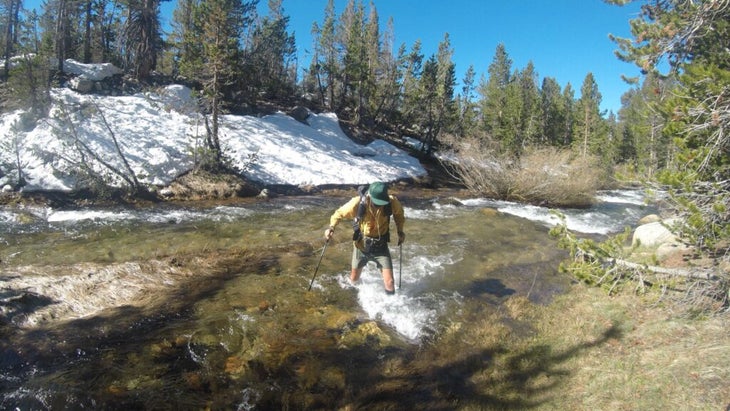
Wildfires, high snow levels, and flooding can impact the trail, so the answer to this may vary from year to year. For example, in 2023, record snowfall in the Sierra resulted in severe runoff that took out a major bridge across the South Fork of the San Joaquin River.
But barring extreme conditions and natural disasters, the best months to hike the John Muir Trail are between June and September. In June and July, there tend to be fewer wildfires nearby and fewer mosquitoes on the trail but a higher likelihood of encountering snow and intimidating stream crossings, so your pace will probably be slower.
The prime weather window for the trail is late July through August, because the snow has largely melted and stream crossings are tamer. Permits are obviously more competitive during these weeks, though, and crowds on the trail tend to peak. My personal favorite time to hike the JMT is late summer. Early September isn’t very buggy or crowded, there’s minimal snow, and stream crossings are manageable.
The downsides to thru-hiking the trail late in the season are much colder nights and an increased chance of a blizzard. You can snag a permit relatively easily though.
When Planning Your Hike, You Should Think About These Five Things
1. Your Resupply Strategy
The JMT has numerous resupply options, but all require advance planning. Shipping time to most locations can take weeks, and options to buy food along the trail are limited, so decide on a resupply strategy as soon as you have a permit, and stick to it.
I recommend stopping at the town of Mammoth Lakes. From Yosemite, it’s about 60 miles and the best place to stock up on food or make gear or apparel swaps before tackling the more difficult part of the trail.
No matter what approach you land on, head into the adventure with the mindset that you’ll only have what you mail yourself along the route, and utilize Mammoth and the other small access points along the way to round things out.
Resupplying options, from north to south, include:
Tuolumne Meadows (seasonal), at mile 23.9: You can resupply here or hitchhike into the town of Lee Vining, but most thru-hikers skip this spot and push on to Red’s Meadow.
Red’s Meadow Pack Station and Resort, at mile 57.3: I recommend catching the bus or hitching into Mammoth Lakes from Red’s Meadow and making full use of its amenities. But Red’s Meadow does accept resupply packages (for a fee) and has a small convenience store and cabins to rent.
Vermilion Valley Resort, at mile 86.5: VVR is a ferry ride across Lake Thomas Edison, or a five-mile hike, from the JMT, but its café accepts packages.
Muir Trail Ranch, at mile 106.4: The hiker box at Muir Trail Ranch is legendary, but the cost to ship a package here is steep. Expect few amenities, because everything is packed in by mule, but make use of it if need be—this is the last chance to resupply before the five highest passes in the southern section of the JMT.
Onion Valley, at mile 177.9: Onion Valley is a 15-mile round-trip detour over 11,709-foot Kearsarge Pass, but well worth it. Kearsarge is one of the prettiest passes in the High Sierra, and this is the last chance to resupply before climbing the highest pass of the JMT. From Onion Valley, it is easy to get a ride out to Highway 395 and the post office in Independence.
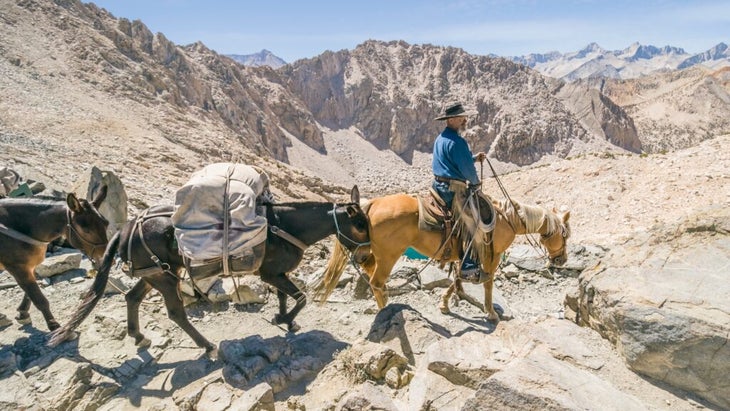
2. Permits
Permits are required on the John Muir Trail, and a ranger will likely ask to see yours at some point along the route. Landing a permit is very competitive, especially the lottery process (with about a 2 percent success rate some years). Enter the lottery six months from your desired start date. The more ranges of dates you apply for, the more likely you are to secure a permit. It costs $10 to enter the lottery and $5 if you’re awarded a permit. During the permit process, you must state which trailhead you will start from, as well as your estimated finish date.
However, if this permit route proves unsuccessful, there’s still hope: the National Park Service reserves 40 percent of JMT permits for release seven days in advance. Of course, this makes planning resupplies difficult, but if you have the time, some of the resupply locations can be reached by car, so you can drop off your resupply packages ahead of time, or ask someone you trust to do it for you.
Once secured, your permit includes backcountry travel and camping along the whole JMT route with an exit out of the Mount Whitney Portal.
Still have questions? The National Park Service offers further clarification on the permit process, along with key dates, here.
3. Weather and Trail Conditions
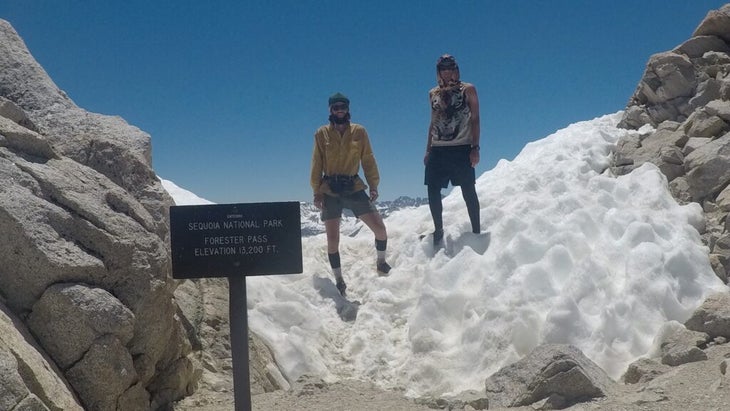
With the route so void of outside communication, having an idea of the weather, stream levels, snowpack, and potential fire issues are essential before starting the trail. There’s no worse shock than arriving at a stream only to see it flowing well beyond your comfort level.
While several good weather-forecasting resources are available through satellite messengers, the storms in the high Sierra move in quickly, often with thunder and lightning. I’ve used an InReach device to maintain contact and to check the weather daily.
Further, a great resource is Mountain Forecast, which offers localized weather forecasts for a number of locations throughout the High Sierra.
4. Self-Sufficiency
Cell service is nonexistent on the JMT, so having all the logistics, maps, and itineraries completed and downloaded beforehand is a must. One platform for this is Gaia GPS, which I’ve used before. There are several side trails (all over high passes) to get out if something goes wrong, but ensuring that this information is available offline is the only way to be aware of such options. Being this secluded also means that help, if needed, will take time to arrive, so you should have basic first-aid knowledge and know how to solve personal health issues should they arise.
5. Your Gear Knowledge
Except for Mammoth Lakes, there are very few areas to change out gear. So practice regularly with your equipment and make sure you’re comfortable in all the possible weather situations, especially rain and snow. Also, remember that gear can fail, so having a small repair kit can be helpful to alleviate some of the stress that comes with adversity. I once had the hipbelt of my backpack rip out while hiking the JMT. A needle and some dental floss were all it took to sew it up and make it through the trip.
Shoe and sock strategy are crucial to nail down before hitting the trail, too. A bad case of blisters can ruin the experience, and wet feet are inevitable with the many stream crossings. I suggest you put in the miles with various shoe-and-sock combinations until you find those that work for your feet in all conditions.
The Gear You’ll Need
There are a few things I wouldn’t hike the John Muir Trail without.
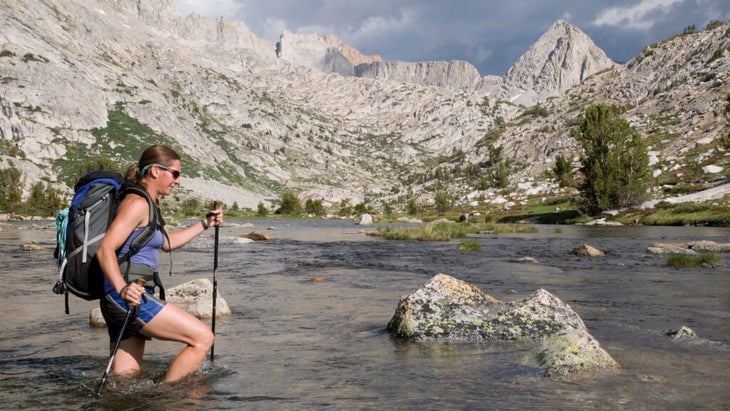
- Trekking poles: These help with climbing and balance on snowy terrain and during stream crossings.
- Quick-drying shoes: Chances are good that you’ll get your feet wet a few times each day. If your shoes dry quickly, you’ll be more comfortable, have fewer blisters, and won’t be weighed down by soggy shoes as long.
- A satellite communicator: Because there’s no cell service on the trail, there will be no weather updates to your phone and no ability to check on whether your resupply boxes have arrived at their locations. A satellite communicator and a support person on the outside willing to help with logistics issues can make problem-solving a lot easier. Also, most satellite messengers offer weather forecasts, and that lets you plan when to climb up and over the high passes. I use an InReach and haven’t had issues throughout the Sierra.
- A bear can: For most of the trail, this is required. And since bear cans come in many shapes and sizes, find one that will fit your food for each of the resupply stretches. It’s not a bad idea to practice how to pack this clunky item in your pack ahead of time—it’ll make hiking a lot more comfortable. I use a BearVault bear can.
- Mapping software: Your phone will work for navigation even without cell service, but downloading offline maps is essential in case something goes wrong. There are a number of mapping applications that work well in the backcountry. Some focus only on the JMT, while others show more side-trail opportunities, too.
- An external battery: Because you’ll be using your phone to navigate, and many of the resupply locations are days apart, you’ll have to recharge your phone each night. Practice with your charger, and know how many times it can recharge your phone, to alleviate anxiety.
- An extra layer: At altitude, the temperature drops dramatically at night, so having another piece of dry clothing to put on at day’s end will make the evenings more pleasant.
What to Expect and Trail Highlights
The JMT is really a trail of sections, each with incredible scenery, high points, and scenic spots. Here’s what to expect while thru-hiking the trail from north to south.
Yosemite Valley to Red’s Meadow: About 57 Miles
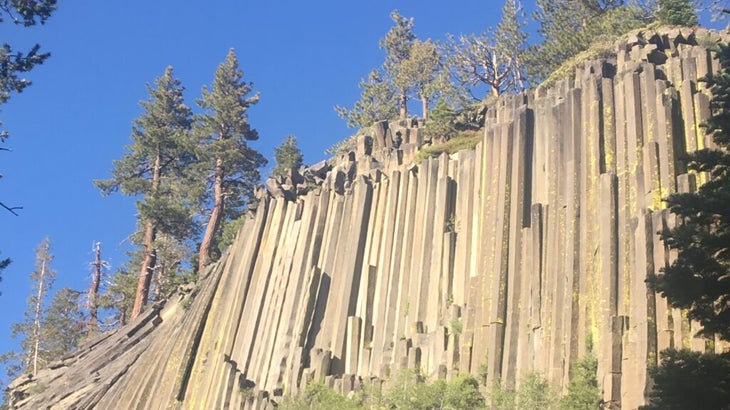
The first quarter of the trail is an introduction to the High Sierra. From Yosemite Valley up and over Donahue Pass to Red’s Meadow, this section features 12,500 feet of climbing and eclipses 10,000 feet twice: 11,073-foot Donahue Pass and 10,226-foot Island Pass. Use these miles to acclimatize to the elevation, enjoy the alpine lakes, and get your hiker legs under you.
Spectacular sights: The first high pass of the trip, Donahue; the majestic Thousand Island Lake; and the unique basalt columns at Devils Postpile National Monument, worth the short quarter-mile side trip.
Red’s Meadow to Muir Trail Ranch: About 50 Miles
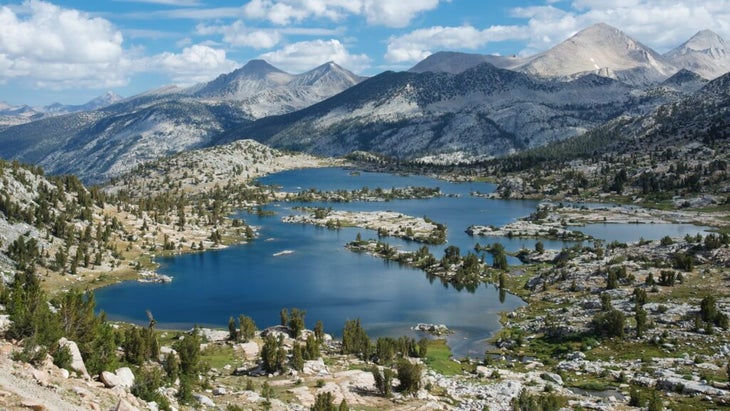
After a possible resupply at Red’s Meadow, with access to Mammoth Lakes via a ten-mile bus ride (unless you want to hitchhike), the trail and camping possibilities expand dramatically. You can camp at a lake nearly every night! The JMT also begins to stay primarily above 9,000 feet, with 9,750-foot Virginia Lake, 10,781-foot Silver Pass, and 10,800-foot Seldon Pass standing out and signifying the even higher passes to come. Depending on the time of year, numerous waterfalls fueled by snowmelt surround and cross the trail through this middle section, making finding a good campsite inevitable.
Spectacular sights: Marie Lake and the drainage off Silver Pass are particularly pretty campsite destinations, along with the option to take a ferry across Lake Thomas Edison to Vermillion Valley Resort.
Muir Trail Ranch to Mount Whitney: About 98 Miles
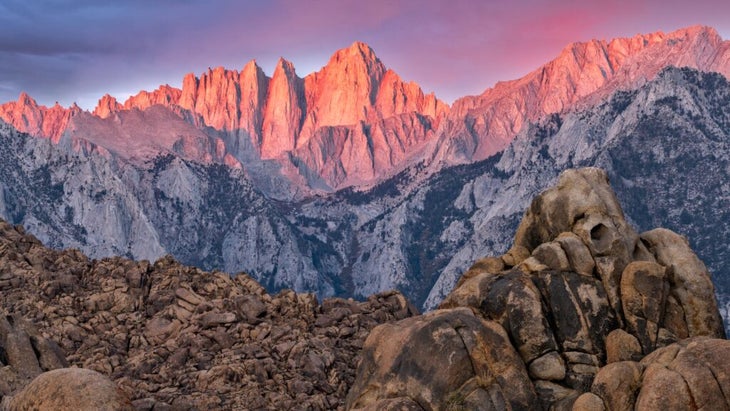
As previously mentioned, the last section of the trail is the hardest. While most of the trail remains above 10,000 feet, be prepared to cross high passes and then drop into massive valleys surrounded by granite peaks before climbing up yet another pass. Five high passes—Muir, Mather, Pinchot, Glen, and Forester Passes (11,955 feet, 12,068 feet, 12,090 feet, 11,926 feet, and 13,153 feet, respectively)—will require long ascents but jaw-dropping views of jagged peaks and cobalt lakes. And it all culminates at the summit of 14,505-foot Mount Whitney, the highest peak in the contiguous United States.
Spectacular sights: Rae Lakes is one of my personal favorite areas, and it has numerous camping options. Of the five passes Mather is my favorite; I appreciate the difficulty, the ruggedness, and the beauty of Palisade Lakes en route to the top.
Where to Camp Along the John Muir Trail
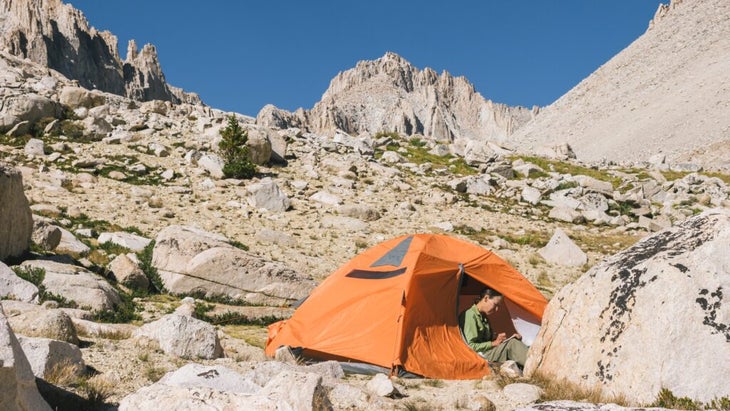
Camping along the JMT is one of the easier parts of this thru-hike, as it’s included with your permit and there are many options. Other than a few restrictions, you can utilize numerous established and backcountry sites. Always keep Leave No Trace principles in mind.
First, two no-no’s. There are a couple of well-marked off-limits camping locations—notably Duck Lake, Half Dome, and Thousand Island Lake—but these restrictions are limited to about a quarter-mile of protected area. Also, campfires are not permitted above 10,000 feet in Sequoia and Kings Canyon National Parks.
These are my favorite sites along the trail:
Thousand Island Lake: Few lakes are as striking as this one. Banner Peak rises 12,936 feet behind it, providing the perfect backdrop. The best camping is on the north side of the lake. Camping is prohibited within a quarter-mile of the lake outlet as well as 200 feet from the shoreline.
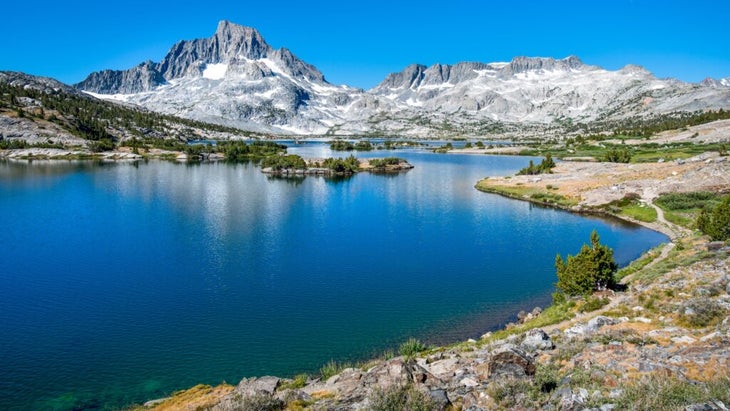
Garnet Lake: Granite peaks and a very picturesque lake dotted with tree-filled islands make this a worthy spot. Camping here is also prohibited within a quarter-mile of the lake outlet.
Evolution Valley: This entire valley is one of the most scenic places in the Sierra. The views at Darwin Bench, on the south side of the valley as you climb past Evolution Meadow, are remarkable, but you won’t be disappointed camping along any of the alpine lakes on the climb up to Muir Pass.
Rae Lakes: This is my absolute favorite campsite of the entire trail. It’s also one of the busiest, but thanks to multiple camping spots, there’s usually a spot to pitch your tent and gaze upon the massive alpine lakes and admire the deep valley. This is also an awesome spot for stargazing.
Worthy Detours and Side Trips
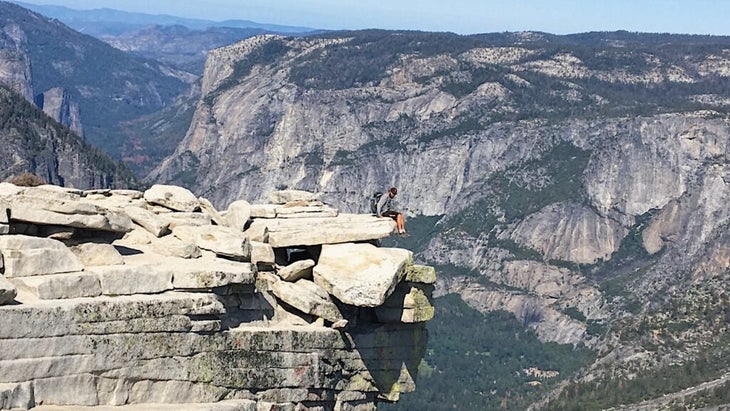
While the John Muir Trail is simply stunning enough, there are two side trips I recommend that are once-in-a-lifetime experiences.
Half Dome, in Yosemite National Park, is a four-mile round-trip detour from the JMT and offers a wonderful panorama of Yosemite Valley. Usually, there’s an option to add a Half Dome permit to your John Muir Trail permit if you’re starting in Yosemite Valley at the Happy Isles or Glacier Point Trailheads.
If you can’t get a permit for Half Dome, a side trip up Clouds Rest in Yosemite National Park is a challenging yet rewarding option. The views of the valley are equally amazing, and a permit is not required. The side trip can either be done as a detour, giving up 6.7 miles of the JMT in exchange for 9.6 miles over Clouds Rest, or a 6.6 mile out-and-back side trip.
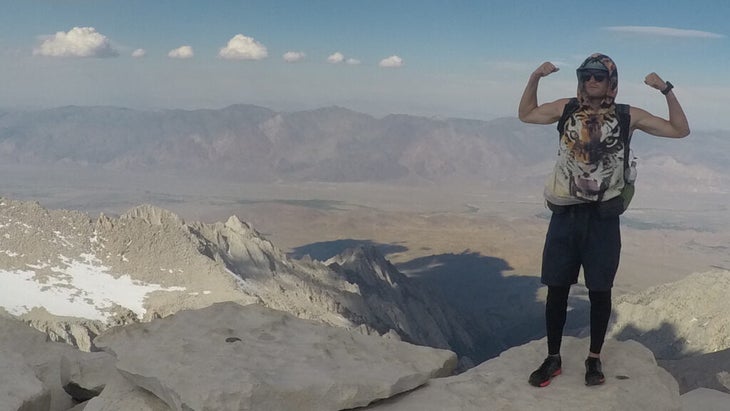
Jeff Garmire has been backpacking most of his life, thru-hiking for 13 years, and he set the current fastest known time on the John Muir Trail in 2022. His 2019 book Free Outside is about hiking the calendar-year triple crown.
Source link

